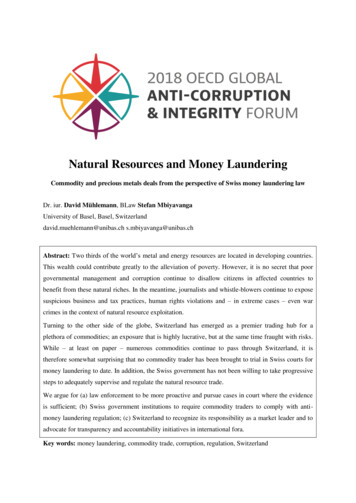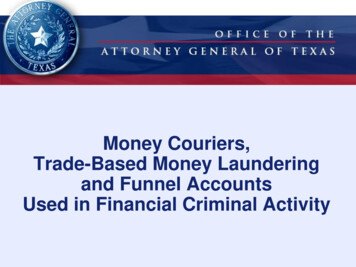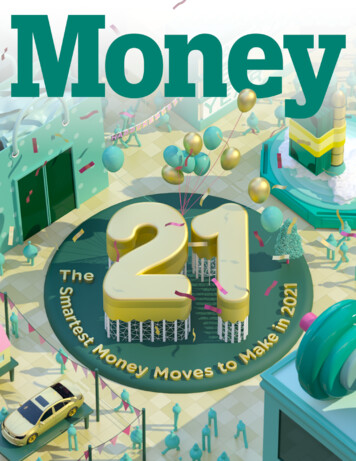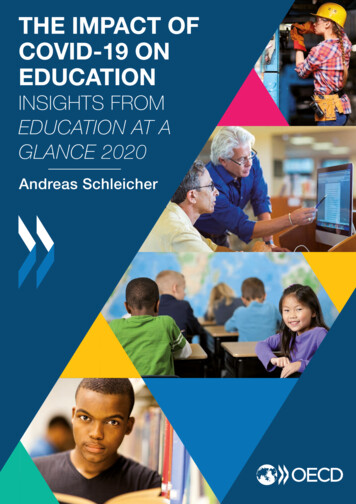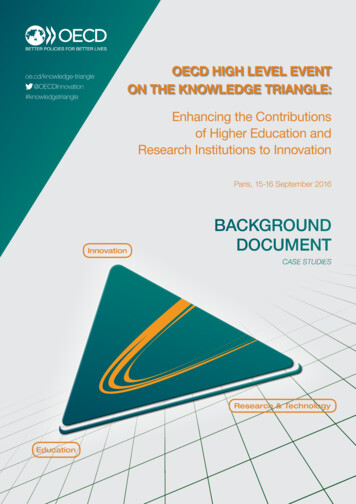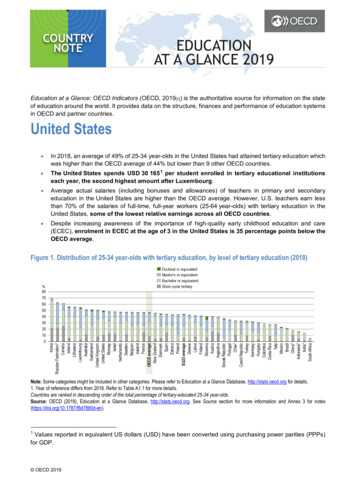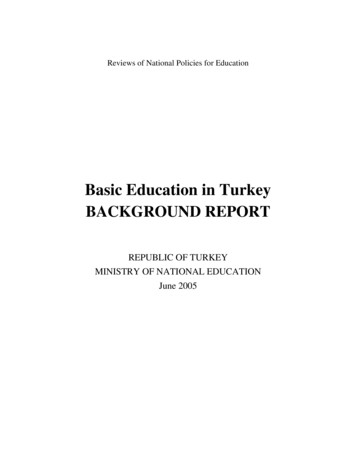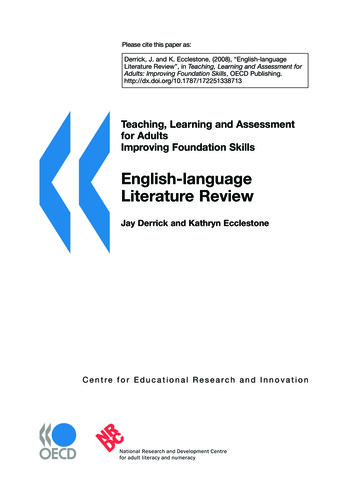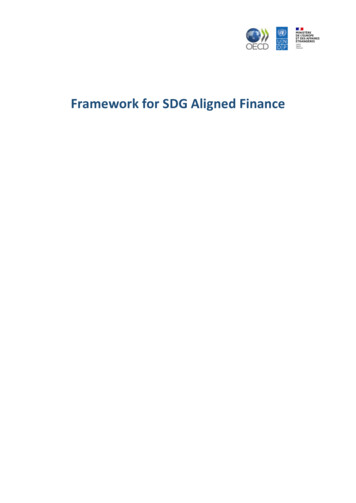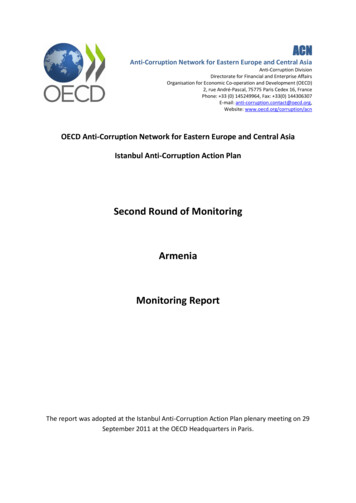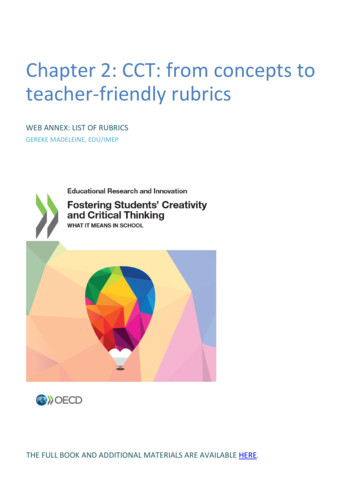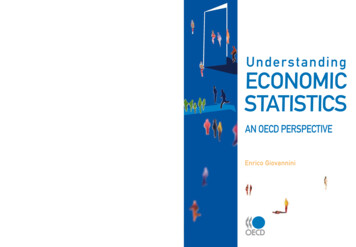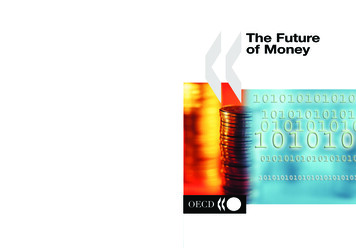
Transcription
«The Future of MoneyThe Futureof MoneyMoney's destiny is to become digital. Throughout the ages physical money in theform of objects, coins and notes has increasingly been replaced by more abstractmeans of payment such as bills of exchange, cheques and credit cards. In theyears to come that trend to virtual money will continue apace. As technologicaladvances in ICT and biometrics come on-stream, as intangibles progressivelybecome the primary source of value-added in the burgeoning knowledgeeconomy, and as the public at large come to grasp the advantages of digitaltransactions, virtual forms of payment will dominate. How quickly will this happenon a major scale, and will cash disappear altogether? How will it affect our dailylives? Will it deepen already existing rifts in society? Does virtual money threatencontrol of the money supply, raising the spectre of greater inflationary risks?Or will it put central banks out of business? This book tackles these and manyother critical questions, offering timely suggestions on why and how to make thetransition to the world of digital money.This book is available to subscribers to the following SourceOECD themes:General Economics and Future StudiesAsk your librarian for more details of how to access OECD books online, or write to us atSourceOECD@oecd.orgThe Future of MoneyOECD's books, periodicals and statistical databases are now available via www.SourceOECD.org,our online library.www.oecd.orgISBN 92-64-19672-203 2002 01 1 P-:HSTCQE V [\W]:2000
OECD, 2002. Software: 1987-1996, Acrobat is a trademark of ADOBE.All rights reserved. OECD grants you the right to use one copy of this Program for your personal use only.Unauthorised reproduction, lending, hiring, transmission or distribution of any data or software isprohibited. You must treat the Program and associated materials and any elements thereof like any othercopyrighted material.All requests should be made to:Head of Publications Service,OECD Publications Service,2, rue André-Pascal,75775 Paris Cedex 16, France.
The Future of MoneyORGANISATION FOR ECONOMIC CO-OPERATION AND DEVELOPMENT
ORGANISATION FOR ECONOMIC CO-OPERATIONAND DEVELOPMENTPursuant to Article 1 of the Convention signed in Paris on 14th December 1960,and which came into force on 30th September 1961, the Organisation for EconomicCo-operation and Development (OECD) shall promote policies designed:– to achieve the highest sustainable economic growth and employment and arising standard of living in Member countries, while maintaining financialstability, and thus to contribute to the development of the world economy;– to contribute to sound economic expansion in Member as well as non-membercountries in the process of economic development; and– to contribute to the expansion of world trade on a multilateral, nondiscriminatory basis in accordance with international obligations.The original Member countries of the OECD are Austria, Belgium, Canada,Denmark, France, Germany, Greece, Iceland, Ireland, Italy, Luxembourg, theNetherlands, Norway, Portugal, Spain, Sweden, Switzerland, Turkey, the UnitedKingdom and the United States. The following countries became Memberssubsequently through accession at the dates indicated hereafter: Japan(28th April 1964), Finland (28th January 1969), Australia (7th June 1971), NewZealand (29th May 1973), Mexico (18th May 1994), the Czech Republic(21st December 1995), Hungary (7th May 1996), Poland (22nd November 1996),Korea (12th December 1996) and the Slovak Republic (14th December 2000). TheCommission of the European Communities takes part in the work of the OECD(Article 13 of the OECD Convention).Publié en français sous le titre :L’avenir de l’argent OECD 2002Permission to reproduce a portion of this work for non-commercial purposes or classroomuse should be obtained through the Centre français d’exploitation du droit de copie (CFC),20, rue des Grands-Augustins, 75006 Paris, France, tel. (33-1) 44 07 47 70, fax (33-1) 46 34 67 19,for every country except the United States. In the United States permission shouldbe obtained through the Copyright Clearance Center, Customer Service, (508)750-8400,222 Rosewood Drive, Danvers, MA 01923 USA, or CCC Online: www.copyright.com. All otherapplications for permission to reproduce or translate all or part of this book should be madeto OECD Publications, 2, rue André-Pascal, 75775 Paris Cedex 16, France.
ForewordLooking to the next few decades, technological advances combined with fairlydramatic economic and social changes could create conditions for the emergenceof new, virtual forms of money and credit. On the positive side these digital formsof money could help to create more efficient and more global economies andsocieties. On the negative side tomorrow’s new forms of money could make it easierto engage in anti-competitive behaviour; exacerbate exclusion and inequality;foster economic volatility; facilitate criminal activity; and even undermine theeffectiveness of macroeconomic policy.To examine these issues and advance the dialogue among high-ranking government officials, business leaders and academics, an OECD Forum for the Futureconference was held in Luxembourg on 11-13 July 2001. The conference had twoprimary aims: first, to explore the interrelationship between new forms of moneyand technological, economic and social change; and second, to consider the implications for leadership in the public and private sectors.The conference was organised around three sessions. The first set the stageby looking back to historic developments, and forward to the technologies thatcould influence future forms of money. The second examined how interactionsover the next few decades between new forms of money and economic and socialchanges could give rise to a wide range of new opportunities and risks. Finally, thethird considered the ways in which public and private sector decision makersmight encourage synergy between new forms of money and technological, economicand social dynamism.The conference was opened on 11th July in the “Hémicycle européen” of theKirchberg Conference Centre by Ms Lydie Polfer, Vice Prime Minister and Ministerof Foreign Affairs and External Trade of Luxembourg; introductions to the theme ofthe conference were given by Mr Donald J. Johnston, Secretary-General of theOECD, and by Mr Luc Frieden, Luxembourg’s Minister of Treasury and Budget. Allthree speeches delivered on this occasion are reprinted in this volume.The opening event was attended by several hundred people from variousprofessional walks of life – government officials, bankers, other financial experts, OECD 20023
The Future of Moneyeconomists, consultants, researchers, university teachers, entrepreneurs, journalists,and many more – from all over the world.The conference benefited from special sponsorship by the Luxembourg Government, the Luxembourg Bankers' Association (ABBL) and the Luxembourg Federation of the Professionals of the Financial Sector (PROFIL). Additional financialsupport was provided by numerous Asian, European and North American partnersof the OECD Forum for the Future.This publication brings together the papers presented at the meeting. It alsoincludes an introduction prepared by the Secretariat. As with all previous Forumfor the Future publications, this introduction not only endeavours to provide anoverview of the main issues at stake and to reflect the richness of the very livelydebate that took place; it also attempts to further advance the thinking on thesubject in hand, inspired by the fruitful discussions at the meeting. The book ispublished on the responsibility of the Secretary-General of the OECD.4 OECD 2002
Table of ContentsExecutive Summary.7Chapter 1. The Future of Moneyby Riel Miller, Wolfgang Michalski and Barrie Stevens .11Chapter 2. Whence and Whither Money?by Michel Aglietta .31Chapter 3. The Future Technology of Moneyby Zachary Tumin .73Chapter 4. Intangible Economy and Electronic Moneyby Charles Goldfinger.87Chapter 5. New Monetary Spaces?by Geoffrey Ingham . 123Chapter 6. Singapore Electronic Legal Tender (SELT) – A Proposed Conceptby Low Siang Kok . 147Address by: Ms. Lydie Polfer . 159Donald J. Johnston . 163Luc Frieden. 167Annex.List of Participants . 1735 OECD 2002
Executive SummaryTo put it in succinct and current terms, money’s destiny is to become digital.This general conclusion emerges from an examination of money’s long historicalrecord and its likely relationship to future socioeconomic changes. Historically,money has been on the path towards greater abstraction, or pure symbolic representation disassociated from a precise physical materialisation, for millennia. Lessevident, when looking to the future, is the question of the rate at which the lastvestiges of physical money will disappear and, in the minds of some, if it is reallydestined to vanish. Views also differ regarding the economic and social importance of traversing this “last mile” and what it would take to achieve it. At one endof the spectrum, Singapore’s Board of Commissioners of Currency is moving forward with a comprehensive effort that is meant to replace, by 2008, the physicalmoney it issues with a functionally equivalent and much more efficient digital system. At the other end of the spectrum, many central banks and governments havetaken predominantly conservative stances, which accounts in part for the verylimited success of recent efforts to diffuse digital money more widely.A case can be made for reconsidering both the significance, in economic andsocial terms, of much fuller digitisation of money, and how to make it happen. Onthe economic front it can be argued that there are high costs, public and private,because of the slow pace at which new payment systems, capable of generalisingdigital money throughout the economy, are being introduced. These costs are notonly the familiar direct ones caused by the large expenses involved in handling,clearing and policing physical cash, but also the less obvious losses associatedwith the difficulties of making the transition towards a “new economy of intangibles”. From this “opportunity cost” vantage point, instantaneous digital paymentsystems that extend throughout the economy are seen as a crucial and still underdeveloped part of the infrastructure necessary for the flourishing of tomorrow’sglobal knowledge-intensive economy where electronic commerce, in all its forms,is likely to be one of the key determinants of overall economic performance.In social terms there is concern regarding the ways in which payment systemcosts are distributed and how accessibility issues will be addressed. Today thecosts of cash (and near-cash instruments like cheques and credit cards) are largelyhidden from consumers. For instance, there is little discussion of the equity OECD 20027
The Future of Moneydimension of the cross-subsidy, imposed when credit card companies prohibitmerchants from offering discounts for cash payment, between people who paycash (particularly the “unbanked” without other options) and those who pay withcredit cards. Similarly, many clearing and settlement systems give rise to expensive service charges and lucrative floats that have serious social consequences inareas such as remittances by foreign workers, providing financial services to theexcluded, or encouraging the start-up of micro-enterprises. Equally serious is thepossibility that a major social fault line could develop in the future when access todigital money becomes the principal way to benefit from lower transaction costsand burgeoning cyber markets.Adding these social concerns to the economic ones makes a strong case forproactive policies that aim to accelerate the diffusion of digital money to the pointwhere it would marginalise physical cash. This conclusion has not emerged frommost other recent discussions of the future of money because, for the most part,the focus has understandably been on the new and exciting technologies thatmight replace the physical with the digital and concerns about the implications ofthese technologies for central banks. Those discussions have provided reassuringconclusions regarding the implications of new technologies for the effective pursuit of macroeconomic policy. However, such a technology-centric approach tendsto obscure both key forces likely to influence the future of money, and importantpolicy issues and tools. Indeed, as became apparent at this conference, policymakers have good reasons not only to increase the pace at which tomorrow’s digital money diffuses throughout the economy, but also to shift the policy focus awayfrom monetary technology (physical) towards monetary agreements and standards(virtual) that underpin clearing and settlement systems that could be used by allparticipants in money-based transactions.Two precedents offer important insights into why it makes s
money has been on the path towards greater abstraction, or pure symbolic repre-sentation disassociated from a precise physical materialisation, for millennia. Less evident, when looking to the future, is the question of the rate at which the last vestiges of physical money will disappear and, in the minds of some, if it is really destined to vanish. Views also differ regarding the economic and .
